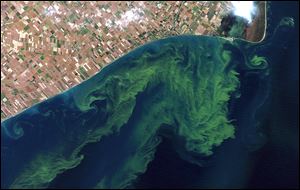
INTERNET PRESENTATION
Scientists: Climate change to worsen Lake Erie algae
11/19/2013
A satellite photo reveals algae blooms swirling on Lake Erie. Scientists expect the blooms to worsen with climate change and modern farming practices.
Climate change has exacerbated Lake Erie’s algae problem and is likely to worsen it in the coming decades with more powerful storms and warmer temperatures, two government scientists said during a live Internet presentation Tuesday.
Richard Stumpf, a National Oceanic and Atmospheric Administration oceanographer in Washington, and Molly Woloszyn, Illinois-Indiana Sea Grant program extension climatologist, said it will take a significant reduction in greenhouse gases to reverse the trend.
Their presentation mirrored many previous findings scientists have made about the Great Lakes region as a whole.
But their focus was on western Lake Erie, which has the Great Lakes region’s worst algae problem.
Two other areas with smaller-yet-significant algae problems, Michigan’s Saginaw Bay and Wisconsin’s Green Bay, are now getting more attention from researchers, said Mr. Stumpf, who specializes in Great Lakes algae research.
This summer’s algae outbreak in Lake Erie didn’t dissipate until late October — a month later than previous blooms had dissipated.
“That’s one of the climate-change impacts,” Mr. Stumpf said, adding that the trend has been for algae to arrive earlier and stay longer.
Lake Erie’s most prevalent form of algae since 1995 has been microcystis, which has a deadly toxin called microcystin. Scientists have said the toxin likely lingers for an unknown time after the algae fades.
Weather records show increasing frequency of thunderstorms and fewer days of light showers since the 1970s in both Sandusky and Erie, Pa., according to Ms. Woloszyn, who also is affiliated with the Midwestern Regional Climate Center at the University of Illinois.
“Overall, Lake Erie is receiving a higher frequency of storms of one inch or greater,” she said.
Many Great Lakes scientists have said the changing nature of storms is every bit as critical to water quality, perhaps even more, than overall figures on rainfall volume, especially between March 1 and June 30.
Heavy rain is when most farm nutrients get washed into the Maumee and Sandusky rivers and other Lake Erie tributaries. A state of Ohio phosphorus task force is calling for a more than 40 percent reduction in runoff, but is not sure how that will be accomplished.
But the December-March runoff is becoming more important too, Mr. Stumpf said, because the region is getting more winter rain than it did in years past.
Earth’s warming climate has reduced Lake Erie’s ice cover in recent winters. Ice is important because it seals off Lake Erie from evaporation, although there is “still quite a bit of uncertainty about lake levels and what they might do in the future,” Ms. Woloszyn said, citing different conclusions in recent studies.
Mr. Stumpf and Ms. Woloszyn made their remarks during an online seminar sponsored by Ohio State University’s Climate Change Research Team, comprising multiple departments within the university. The presentation was viewed by more than 500 people, many of them scientists.
The 2012 drought was consistent with climate change, which is characterized by extremes of both major storms and drought, Ms. Woloszyn said.
“There may not be a significant change in total precipitation, but we will see an increase in storms and drought,” she said.
Mr. Stumpf has coordinated NOAA’s fledgling algae-forecasting program for western Lake Erie.
It started in 2012. NOAA accurately predicted an algae-free lake that summer. The region underwent its worst drought in 50 years in 2012.
NOAA’s forecast was made months after 2011’s record algae outbreak, which Mr. Stumpf said now appears to be the worst of all time — not just in recent years.
Lake Erie was fouled by so much untreated sewage and direct releases of industrial waste before the modern era of sewage treatment began in the 1970s that it was declared a nearly dead body of water. Debris in one of its tributaries, the Cuyahoga River near Cleveland, actually caught fire multiple times, but is best-known for one blaze that made national news in 1969.
Many Great Lakes scientists have said the NOAA forecast for 2013 — predicting a significant, but not unusually large algae outbreak — fell short of what actually happened.
Tom Bridgeman, the University of Toledo’s top algae researcher, told participants of the UT College of Law’s annual Great Lakes law seminar this month that the 2013 outbreak was the second-worst in open-water areas since at least 2000.
Mr. Stumpf said Mr. Bridgeman has strong data for near-shore areas of Lake Erie’s western basin, but that NOAA looks at the lake as a whole. “We cover a much broader area,” Mr. Stumpf said.
NOAA is in the process of crunching its 2013 algae data, he said.
The agency believes its forecasting system is as accurate as can reasonably be expected, Mr. Stumpf said.
“Our precision seems to be pretty good,” Mr. Stumpf said.
Mr. Stumpf also said the Army Corps of Engineers’ practice of dumping dredged material from the Toledo shipping channel into the open water of western Lake Erie’s North Maumee Bay “could have a very localized effect” on algae growth.
State Sen. Randy Gardner (R., Bowling Green) last week proposed an amendment to a nutrient management bill that would phase out that practice in Ohio waters. It marked the first time the open-lake disposal controversy has been addressed in legislation by the Ohio General Assembly.
Contact Tom Henry at: thenry@theblade.com or 419-724-6079.